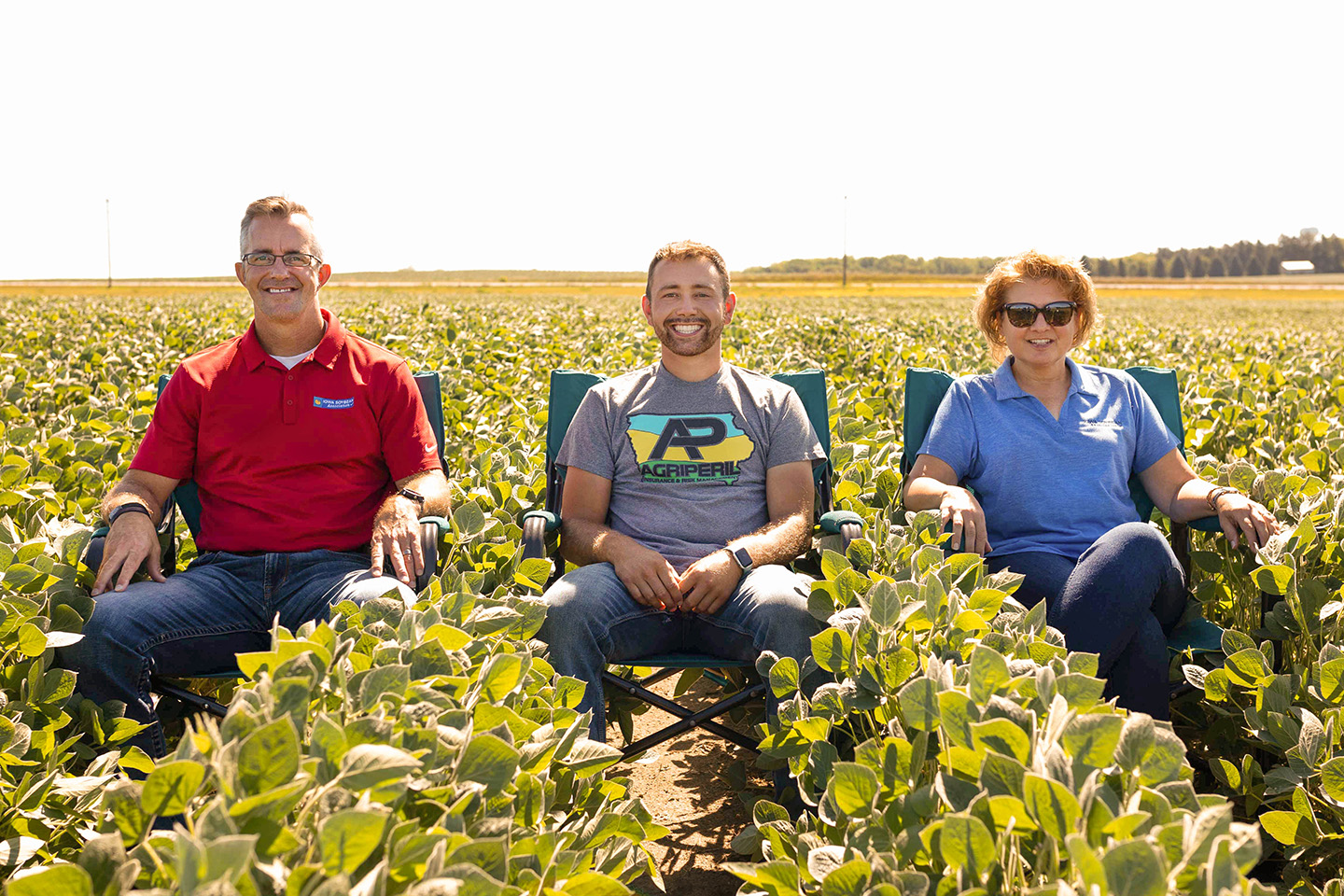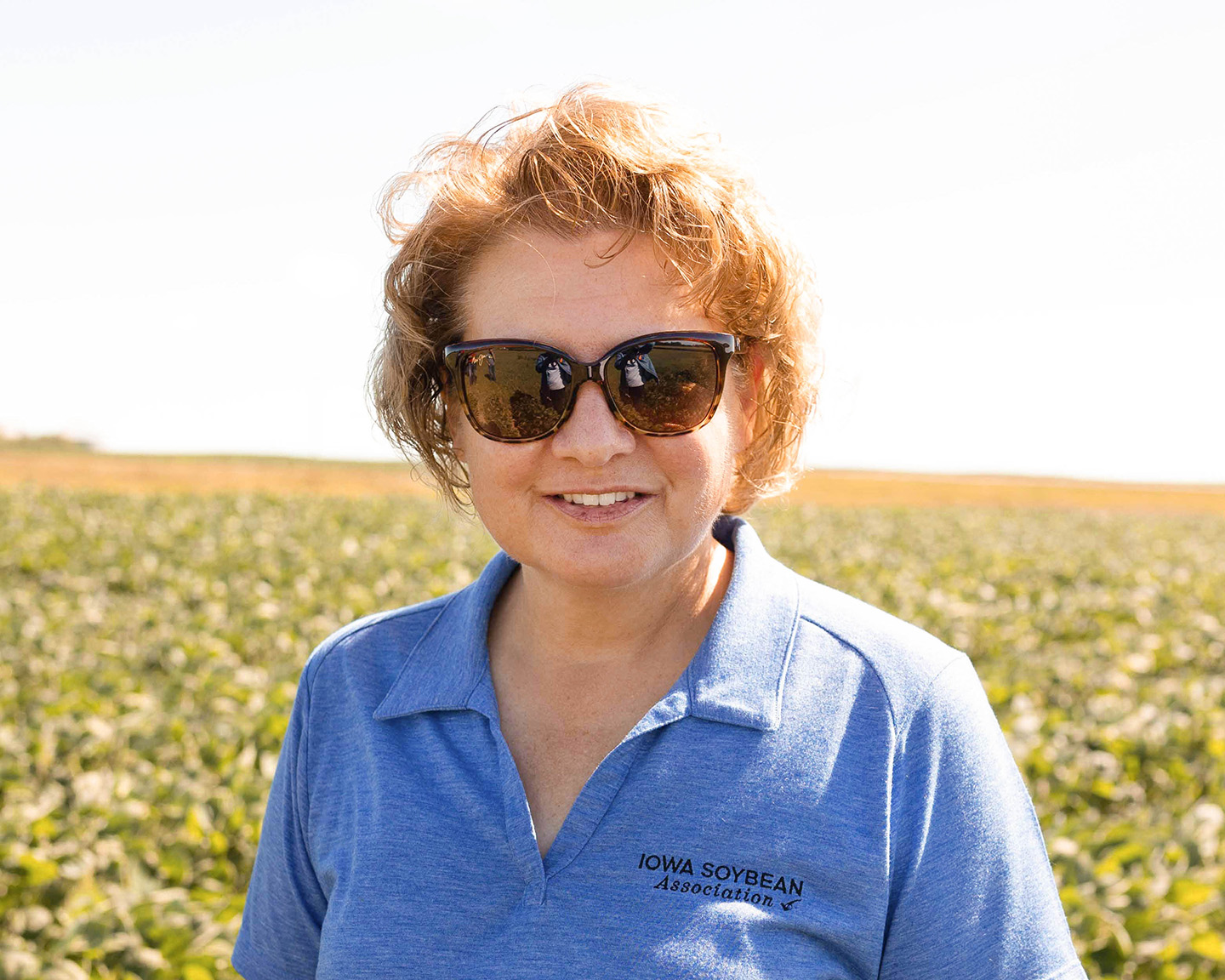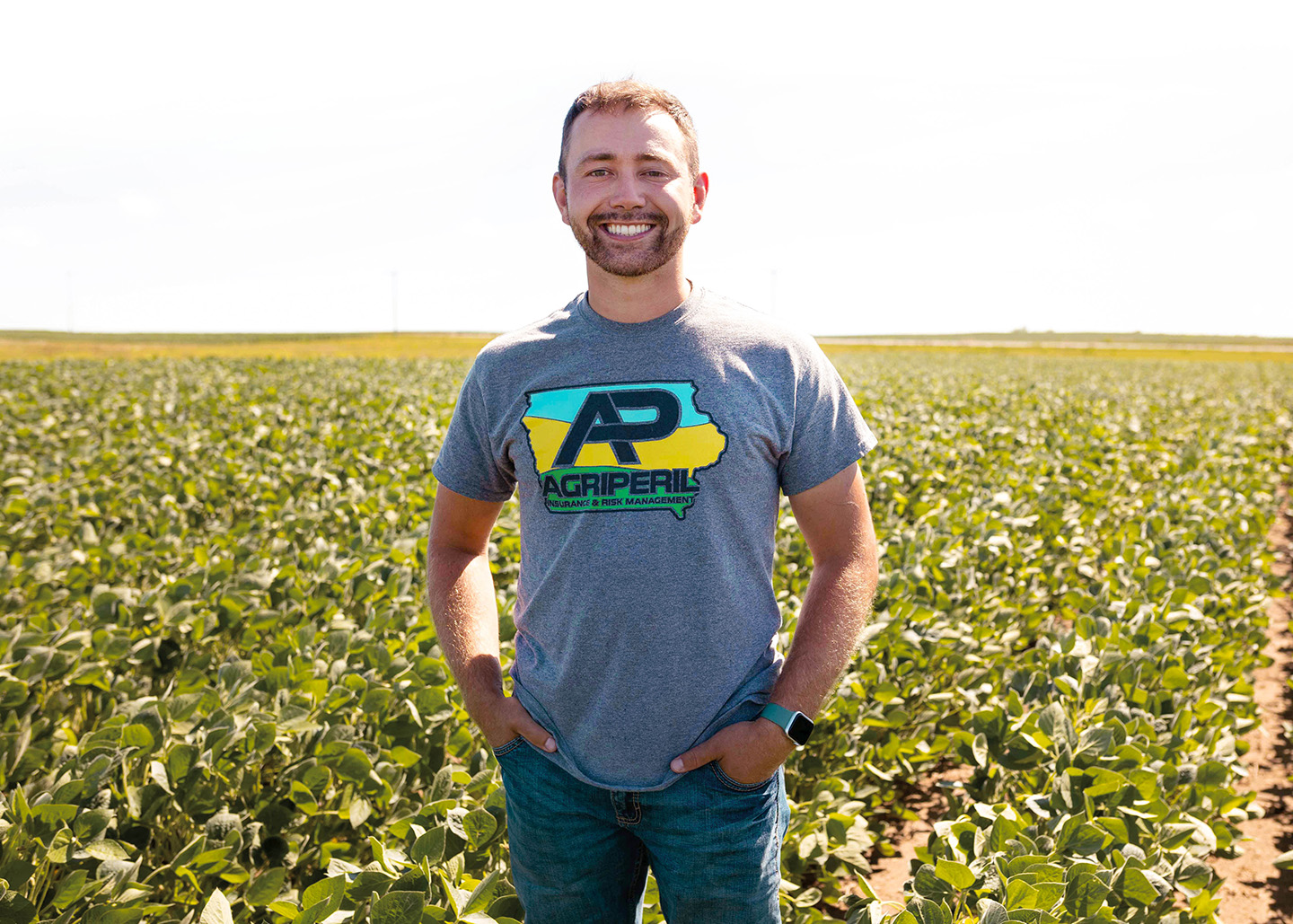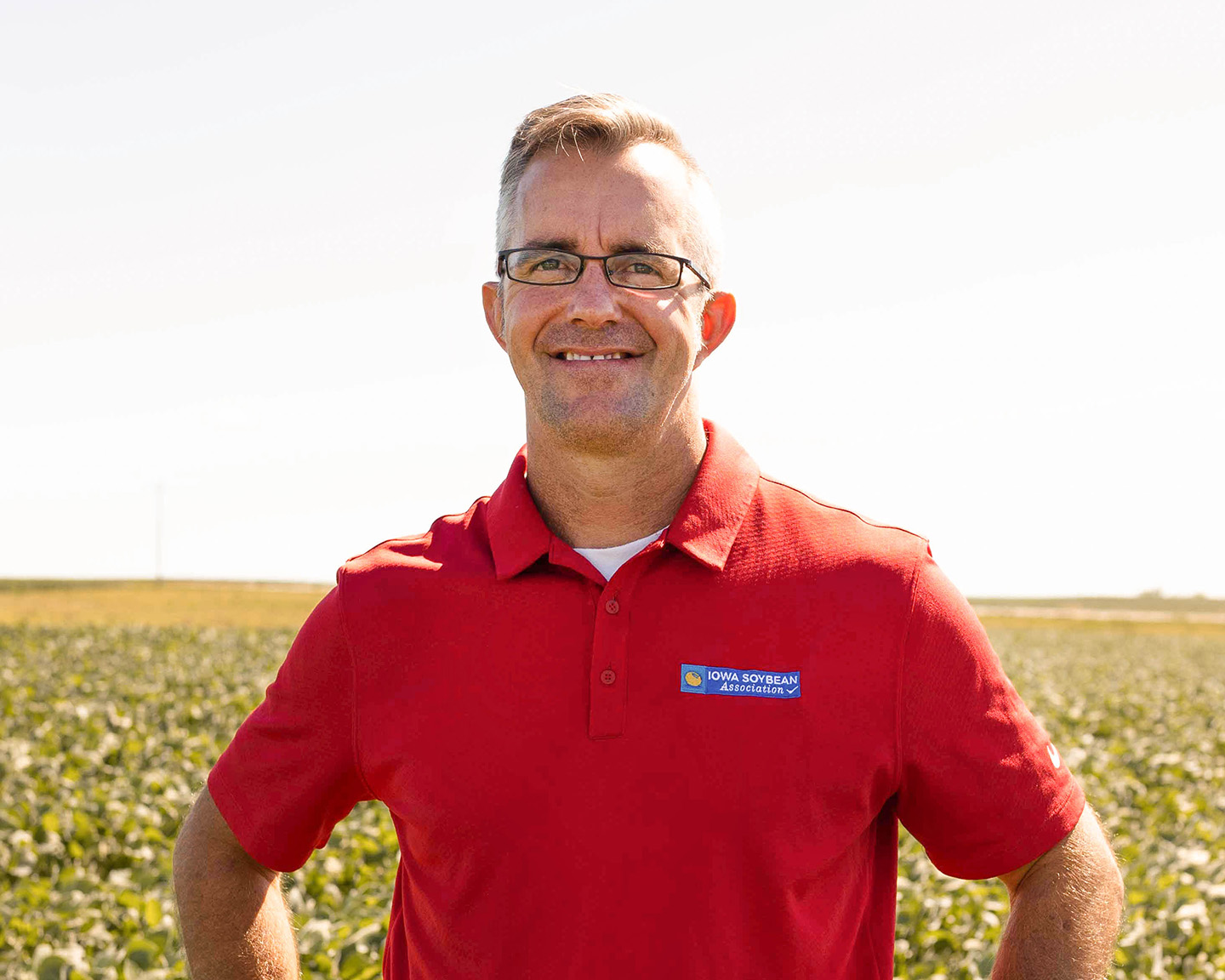
(Photo: Joclyn Bushman/Iowa Soybean Association)
3 Iowa farmers plot out soybean farming's future
September 26, 2022
What’s the key to a soybean farmer’s success in 2022 and beyond?
A recent conversation between three Iowa Soybean Association (ISA) farmer-members suggests acting on new opportunities, fostering successful communication with the public and serving as an advocate of agriculture are paramount.
Reed Burres, Suzanne Shirbroun and Brent Swart gathered around the table at Burres’ Humboldt County farm to talk shop: offering their perspectives on farming today and in the future.
Snapshot of soybean farming
“We have tons of opportunities to look forward to,” says Swart, an ISA District 1 director who farms near Spencer. “The most exciting parts are the new uses and markets we’ve been working on for soy. If we look at 2023—and input costs rise like they’re projected—there is likely to be a larger shift to soybeans. We have to be prepared for this possibility.”
“I think that’s exactly right,” says Burres, an ISA District Advisory Council member and the 2020 ISA Young Leader Award recipient. “It goes back to our current market trends and commodity prices. Everyone is chasing profitability. I don’t think there has been much focus and emphasis on increasing yields. It seems as though we see increasingly good yields. Then on the other hand, it seems like 60-bushel beans are still kind of an oddity in certain pockets of the county and state. How do we get more consistency, and how do we get the yield along with the price to cooperate and be more competitive?”
Shirbroun, of rural Farmersburg in Clayton County, and secretary of the executive committee on ISA’s board of directors, says uncertainty is part of being a soybean farmer.
“On my side of the state, we still see a lot of corn-on-corn acres. The tough part about soybeans is getting consistent yields. You can do everything right with soybeans and still not hit your yield goal for whatever reason – maybe you didn’t get that right rain in August or September. It’s more of a challenge to get soybeans to reach that full potential. I don’t know if more research is needed or if it’s just the nature of the beast.”

“You have to weather the highs and lows. If you want a sports analogy, I go for base hits, not home runs. Celebrate the wins but be prepared for the losses.” - Suzanne Shirbroun
Regulations and regulators
The three farmers agree soybean farming in Iowa has a plethora of positive aspects, but there are different pressures to contend with – be it agronomic, political or policy.
“We’re in a state of flux,” Shirbroun says. “It’s a lot of little things.”
“I had the opportunity to go to England, the Netherlands and Spain with the Iowa Soybean Association on a learning mission. It was a cautionary tale of what happens when you sit back and are pacifists. Benno van der Laan (an international expert on agricultural issues) gave us the background and said from the beginning of the EU in the 1980s and early ’90s farmers there would jump through regulatory hoops. Now they’re to a point where the agricultural sector cannot keep up or compete with the rules being made in the EU and the NGOs (non-governmental organizations) thrown in there.”
Shirbroun continues, “Iowa farmers have a lot of positives but at the same token, we have a lot of work ahead of us in moving potential soybean meal, oil and whole soybeans that we’re expected to produce in the near future.”
Burres reflected on a recent trip to the U.S. capital with other farmers.
“We discussed dicamba, all the rules and regulations,” he says. “The commonality was ‘we’re farming with one hand tied behind our backs.’
“I’m sure it’s only going to get worse in the long run, but it will be interesting to see what political oversight Iowa farmers might experience.”
Legislators are one piece, but there’s also the Environmental Protection Agency (EPA) and the Securities and Exchange Commission (SEC), which provide additional oversight, the farmers add.
“We’ve already lost Lorsban,” Shirbroun notes. “And what are you going to do if you have spider mites on your soybeans?”
“They’re taking away some of our valuable tools,” Swart says. “We must continue speaking not only with legislators and those from non-agricultural states, but also department heads, the EPA and SEC. The need for broader dialogue needs to be emphasized going forward.
“Sometimes we go to D.C. or the statehouse, and we talk to our friends who support us. It makes everybody feel good, but are we moving the needle?”
“I agree,” Shirbroun says. “It’s important that we talk to legislators and those from the non-agriculture states.” Continuing to talk to friendly policymakers is still essential, Burres says.
“Regardless of what political spectrum you’re on, we are blessed to have kind of a bipartisan state – with representatives from both Democratic and Republican parties in office. Our legislators want to take care of us, and they will convey the necessary points to their colleagues in Washington, D.C.”

“There’s a lot to be said about taking the time to have a two-minute conversation with someone. It might change their perception of agriculture.” - Reed Burres
At the forefront
“Legislators and consumers – they drive the ship,” Swart says. “We have to be better advocates for agriculture and share with consumers what we do.”
“When we were in London, we had a chance to meet with their version of the Iowa Farm Bureau, and their big concern now is communicating with consumers,” Shirbroun says. “There is such a big push, especially from the EU – they want 25% organic production by 2030 – it’s frightening. Even though England left the EU, they’re still influenced by the NGOs and everybody else.
“So now, EU farmers are trying to figure out how to communicate with consumers that their food is safe. That was a big topic of conversation.”
The three farmers agreed that in person, face-to-face conversations are the best way to connect with consumers.
“There’s a lot to be said about taking the time to have a two-minute conversation with someone,” Burres says. “It might change their perception of agriculture.”
Swart echoed the sentiments of his fellow farmers:
“Consumers want to talk to farmers,” he says. “Some farmers see the dialogue as an adversarial relationship, that they’re out to get us or take our products away or poke holes in our management systems.”
Instead, those conversations should be viewed as an opportunity to advocate for what farmers are doing here in Iowa, Swart says.
Shirbroun shared how for three years during high school football games, she and a local schoolteacher, originally from downtown Milwaukee, would talk about a host of topics.
“Finally, one day she asked, ‘What do you do all day out there on the farm?’” Shirbroun says.
“She’s teaching in a rural community and admittedly didn’t have a clue,” she says. “But those are the kind of conversations you must have.”
Swart adds, “The more we can educate them, the better.”

“You know, we have a lot of problems in our society. The exciting thing is there are a lot of problems where soybeans can be a solution – more protein in your diet, biofuels and new uses in asphalt or rubber. Soybeans are so flexible.” - Brent Swart
The challenges ahead
The economics and return on investment in agriculture are still top challenges, farmers say.
“Even though we’re in extremely good times now, we need to be thinking five years down the road and realize this is not going to last forever,” Swart says. “Where do I put my chips on the table to continue my success and get through that dip in the economy?
“We have good times right now, but I still worry,” he says. “That’s the thing that keeps me up at night – how to position myself for the long haul.”
“I think we can all appreciate that concern,” Burres says. “To be diligent and pragmatic. We’re trying to be smart and to grow appropriately.”
Shirbroun says overall uncertainty is the challenge.
“Do I prepay fall anhydrous now or later? Inputs, do you or don’t you pull the trigger? Do you sign the contract for the next grain bin? These are things I’m thinking about,” she says.
“The learning mission to the EU was an eye opener. Now, I’m more concerned than ever about policy. Someone in Brussels, Belgium, will influence how we market and sell our crop here in Iowa. That’s my concern.”
But uncertainty creates opportunity and that’s the positive part, Swart counters.
“We can create those opportunities for ourselves, our neighbors and fellow Iowa soybean farmers,” he says.
“It’s a tough gig,” Shirbroun says. “But as farmers, in general, we’re willing to take the risk.”
Opportunity abounds
As to the best part of being a soybean farmer right now?
“The potential is amazing,” Shirbroun says of new uses for soybeans. “Sustainable aviation fuel, go right down the list – being on the forefront of it and watching it develop. The potential is great and that’s exciting.”
“The market demand for soybeans - it’s going to be interesting to see our fall farm price,” Burres says. “It might eclipse our spring price. In my farming lifetime, we have the best opportunities right now. What’s next? New demand, new uses for our soy-based products … I think that’s the silver lining of being with ISA – we have a chance to express our concerns and thoughts.”
Swart agreed. “You know, we have a lot of problems in our society,” he says. “The exciting thing is there are a lot of problems where soybeans can be a solution – more protein in your diet, biofuels, new uses in asphalt or rubber. Soybeans are so flexible.”
Challenges and opportunities abound, but what about surprises?
“I’m still waiting for an average growing year,” Burres laughs.
“In my career, nothing surprises me anymore. I just monitor the ebbs and flows and try to navigate the situation,” Swart says.
“As a mother of three sons, nothing surprises me,” Shirbroun says. “You have to weather the highs and lows. If you want a sports analogy, I go for base hits, not home runs. Celebrate the wins but be prepared for the losses.”
Grading the present
“I hope we can see an increase in productivity per acre in soybean production,” Burres says. “If we can see higher yields … it would make me more confident about long-term consistency. Crop insurance guarantees are great, but actual money in hand is better.”
Swart says eliminating bureaucracy and seeing more ISA and university research projects through is important.
“As an organization, we’re coming up with great ideas, but we need to find a way to clear some of the roadblocks and hurdles to the finish line,” he says.
As to what’s happening in the Iowa soybean industry, what would these farmers offer as a letter grade?
“I’m going to grade us a B for a couple of reasons,” Swart says. “We can always get better, and we always have to strive for improvement. When I look at our competitors in South America in terms of conservation – they are miles ahead of us.
“I think we’re doing good things. I believe we are good stewards of the land, but we can always do better.” Burres agreed. “I would say a B. What can we focus on to ensure we have those long-term opportunities?”
Shirbroun modified her grade slightly. “We have so many positives going on for us right now. I’m going to have to give a B+!”
Back